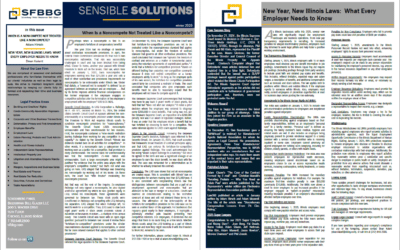Like other businesses, sales representative organizations are purchased and sold for a variety of reasons. What distinguishes sales representative organizations in the purchase and sale context is that the owners generally do not sell their businesses to unrelated third parties. Rather, sales representative businesses are typically sold to employees of the business, children of the owners or other related parties. Related party transactions often cause buyers and sellers to take a holistic view of the purchase and sale transaction, both from a business and a tax perspective. Unlike conventional purchase and sale transactions where buyers and sellers negotiate the income tax aspects of the transaction for their personal benefit, determining the tax structure in the purchase and sale of a sales representative organization is often done on a collaborative basis.
Consider a sales representative organization conducted in the form of a S corporation where the seller sells and the buyer purchases the stock of the business. From the seller’s perspective, if the seller held the stock for a period of more than one year, any gain from the stock sale will be taxable to the selling shareholder as a long-term capital gain. With a federal capital gains tax rate of 20 percent and other federal impositions and state income tax rates which vary from state to state, it is not unreasonable for a seller to pay income tax in the 30 percent range on the gain from the sale. In a stock purchase transaction, no income tax deduction is allowed to the buyer for amounts paid to purchase the seller’s stock. In this case, viewing the buyer and seller together, the result is a net outflow of 30 percent for taxes to the governing tax bodies.
Suppose that instead of a transaction involving the purchase and sale of stock, the seller sells and the buyer purchases the assets of the seller’s business. In the case of asset purchase transactions, governing tax rules require the purchasing and selling parties to allocate the purchase price among the assets bought and sold based on the fair market values of such assets. Ignoring some complexities which are not generally relevant in these circumstances, the purchase price must first be allocated to accounts receivable, then inventory and then tangible personal property with any excess portion of the purchase price allocated to goodwill. After the purchase price is allocated to each asset sold, the seller’s gain or loss is computed based on the difference between the portion of the sale price allocated to each asset sold and the purchaser’s tax basis in each asset which is often the price the buyer paid for such assets.
In the sales representative world, very few organizations hold meaningful amounts of accounts receivable, inventory or tangible personal property. While many sales representative organizations hold contracts with the manufacturers they represent, little value is often placed on these contracts as they can usually be terminated by the manufacturer on short notice. The result is that the largest portion of the purchase price of a sales representative organization can be allocated to goodwill. While goodwill can have different meanings, the goodwill of a business organization is the intangible value of the business which is not attributable to specific business assets. The general reputation of a business in the industry is an example of goodwill.
Now consider instead a sales representative organization where the transaction is structured as an asset sale and virtually all of the sale price is allocated to goodwill. Goodwill is a capital asset so any gain from the sale of goodwill is taxable as a capital gain. The tax result for the seller is similar to the tax imposition from a stock sale as the seller will report any gain from the sale as a long-term capital gain assuming the one year holding period requirement is satisfied. From the buyer’s perspective, the portion of the purchase price allocated to goodwill can be amortized and deducted over a 15-year period. Assume the buyer is in the 35 percent combined federal and state tax bracket and the present value of the goodwill deductions over the fifteen-year amortization period is 60 percent of the purchase price. In this case, there will be the same net outflow of taxes of 30 percent paid by the seller but the buyer will enjoy an effective tax savings of 21 percent (the 60 percent present value of the amortization deductions multiplied by the buyer’s 35 percent tax rate). In this scenario, the net outflow of taxes to the government is only 9 percent. The parties have collectively benefited from the transaction being structured as an asset purchase and sale with the purchase price allocated to goodwill.
Now consider another variation where the seller agrees to render services for the buyer after the sale and virtually all of the purchase price is attributable to the services the seller will render, whether as an employee or as an independent contractor. In this case, the seller will be taxed on the full amount of payments when received as ordinary income where the highest marginal federal income tax rate is 37 percent. The buyer in turn will be able to deduct the full amount of the payments made. Ignoring payroll taxes which in many cases are not a factor, the transaction could result in no significant net outflow of taxes to the government as the amount taxed to the seller will equal the amount deducted by the buyer.
In the last scenario, while there is tax neutrality, the seller shoulders a disproportionate share of the tax burden since the entire amount of consideration paid is subject to ordinary income tax. The parties can increase the payments to the seller to place the seller in the same position the seller would have been in had all of the seller’s gain from the sale been treated as a capital gain. The increased payments will be subject to income tax which can then be factored into the equation. Nevertheless, the parties can largely achieve tax neutrality without doing disservice to either party.
There are numerous factors which must be considered in the purchase and sale of a sales representative organization. Income and other taxes are no doubt a significant factor. As the purchasing and selling parties negotiate the purchase and sale price for the transaction, the focus should not just be the amount of the purchase price but rather the amount of the purchase price paid and received after taxes. Too often the parties in a business transaction focus on tax issues after the transaction has been consummated. Where the parties are intent on minimizing the overall tax burden for both parties, a through analysis of the tax aspects of the transaction is essential.
Please contact Bruce Bell with any questions at (312) 648-2300 or e-mail at [email protected].



